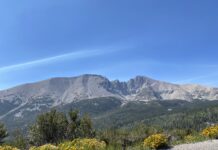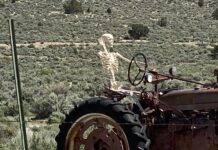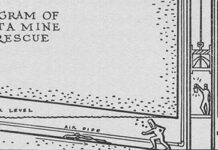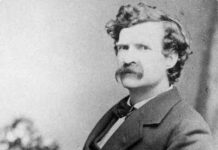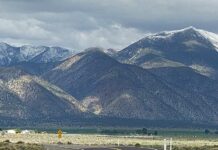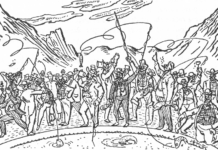We had a great time at the Nevada Northern Railway‘s Centennial celebration.

We stayed over the night before in Eureka, and managed to get into Ely in time to join in the pancake breakfast that began the proceedings. There were crafts and food booths, auctions silent and out-loud, several re-enactments of the Driving of the Copper Spike, a savory barbecue and music, music, music, but the stars of the show were the trains.
There were two excursion trains Friday, five more on Saturday and two again on Sunday, all manned by volunteers and filled with celebrating visitors. Guest Celebrity Engineer John Tyson was at the throttle of old #40 as we eased out of the East Ely depot on the 12:01, bound for the mines at Ruth.
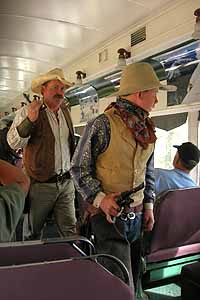
Our coach — which once brought the high school kids in and back from McGill every day — swayed and swung along, lurching and tap-dancing click-clack clickety-clack through the back streets of Ely, above the Renaissance Village, above the brothels and into the throat of Robinson Canyon.
We chuffed up through two tunnels, one long and curved, the other short and straight, on the long climb to the old mining company town of Ruth.
On our return we were sidetracked to allow the 3 o’clock diesel to roar slowly past, and then a gang of desperado’s climbed aboard, freely brandishing their six-guns, although mercifully they did not shoot them off. We stopped again at Renaissance Village, a collection of miner’s cottages being restored to emphasize the varied ethnic backgrounds represented in the early years of mining here.

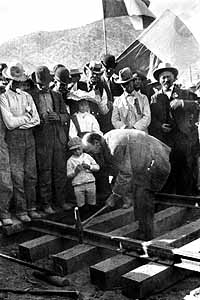
On September 27, two days before the official 100th anniversary of the Final Spike, the NNRY was designated a National Historic Landmark. “These new National Historic Landmarks help tell the story of America as a country and of Americans as a people — our history, our land, our culture, our literature and architecture and our struggles,” proclaimed Interior Secretary Dirk Kempthorne.
The designation specifies that the “Nevada Northern Railway, East Ely Yards, Ely, White Pine County, Nevada, is the best-preserved, least altered, and most complete main yard complex remaining from the steam railroad era.
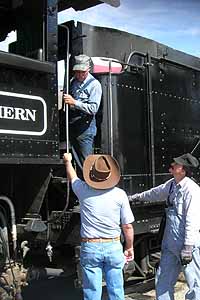
“The Nevada Northern Railway was established in 1905 to support the area’s booming copper mining industry. The era of dieselization of the railroad industry during the second half of the 20th century led to alterations and demolitions of railroad yards and shops nationwide. The East Ely yard escaped modernization because of its geographical remoteness and the decline of the mining industry it once served.”
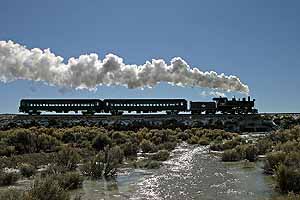
Copper mining has resumed here since the traumatic Kennecott shut-down 50 years ago. First came an Australian company named Magma Nevada, and more recently the Robinson Mining Co. is carrying on production.
The railroad buffs had traveled from near and far to be present and 400 of them attended the a banquet feast and another 80 enjoyed German food on the Oktoberfest train. Everybody enjoyed David John and the Comstock Cowboys, who played a memorable concert.
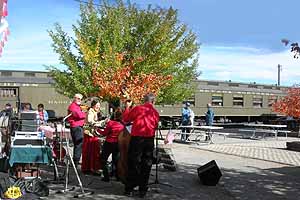
We had a lot of fun, and I’m a little sad that we have to wait a hundred years before we do it again.
And then I look at the schedule and see “Haunted Ghost Train starts October 7 and run Saturdays through October 28. Reservations Suggested. Starting October 2 Saturday’s train times are: Steam at 1 pm, Haunted Ghost Trains at 7 pm; Sunday’s trains are Steam at 9:30 am and Diesel at 1 pm”.
And when it snows they run the Polar Express. The railroad is a national treasure, it goes without saying, but there’s another treasure there too: the expertise, practical ability and perseverance of the small staff and the many volunteers who have combined to dedicate themselves to preserving the railroad at the top of its form.
Email of the Month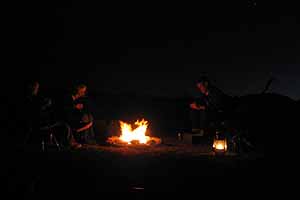  Yes, got the map. Thanks! I should really thank Sam too. He delivered it to a friend’s house, one of the guys that went on the trip. He called me and said, “Hey, someone dropped off a really great map of Nevada that has everything cool in it! You should see this thing!” |
Their performance has always been in a supporting role to the big stars (#40 and #93) and it has always been exceptional. I hereby nominate them as Nevada Travel Heroes.
The 2006 Centennial Coins are now available. It’s easy to get one, just join the museum: Basic Membership $15 (no coin); Active $30 and Family $50 (copper coin); Centennial $100 (silver coin); Patron $500 (gold plated silver coin) and Lifetime $1000 (one coin of copper, silver and gold plated silver) Contact the museum for more information: 775-289-1663.
Last time I rashly offered to provide a list of the Ten Essential Nevada Books that everyone with a Nevada Bookshelf should have. That’s not as easy as it used to be, because Nevada is no longer defined so completely by its history. Not so long ago Nevada was still as isolated and unique as it had always been, but now that’s over, and that changes the list. Here are my candidates, with some serious fudging. I can’t do more here than list the titles with an inadequate sentence or two, but I will post a fuller discussion on the web; check for the link in the next NevadaGram. I’d be interested in knowing about the Nevada books that you have on your bookshelf and why you have them there.
1. The Thompson & West History of Nevada. This weighty volume was written by a skillful journalist named Myron Angel when the pioneer experience was still fresh in Nevada. When Thompson and West originally issued the 680-page book, the Territorial Enterprise greeted it with enthusiasm. The new book, it predicted, “will either take its place as a standard work of reference, or will serve as the basis at some future time for the history which is to be written after the present generation passes away.” Right on both counts. (If you can’t afford it or can’t find it, Sally Zanjani’s new book is a partial substitute; “Devils Will Reign” tells the story of the state’s earliest days as a part of Utah Territory and then as a Territory in its own right, up to Statehood in 1864.)
2. Roughing It, by Mark Twain. This is Twain’s brilliant telling of his Nevada adventures, a great book by any standard. It is a classic of the American West, and it should be on everyone’s bookshelf, not just yours
and mine. It was written in 1872, a little more than 10 years after Sam Clemens deserted his Confederate militia unit and headed out for Nevada with his brother Orion.
3. Nevada Ghost Towns & Mining Camps, by Stanley Paher. Forty years ago Paher traveled throughout Nevada pestering people for a look at the family photo albums they kept as monuments to the time when they and Nevada were young. He prowled the courthouses of the state, poring through bales of records, documents and maps and managed to pinpoint the locations and histories of more than 600 mining towns, logging camps, ranching villages, railroad shipping points, military posts, trading posts, Pony Express stations, stagecoach depots, way stations and spas in Nevada and the adjacent parts of Oregon, Arizona and California. The encyclopedia which emerged from his prodigious researches is illustrated with over 700 photographs of pioneer settlements in Nevada, and was an undisputed classic the moment is appeared.
4. Martha & the Doctor by Marvin A. Lewis. This is the powerful depiction of the experiences of James and Martha Gally and their two children in and around Austin during the ten years beginning in 1864. Their struggle to maintain themselves on the far frontier with no other resources than their courage and determination makes for dreadful, absorbing reading. It is a harrowing picture of family life in the desert wilderness of early Nevada, and of the courage and devotion required simply to endure. The story has a happy ending (more or less), but its great lesson for the modern reader is its unvarnished and highly personal depiction of the frontier reality. This is a fine book about very real people.
5. Nevada, The Great Rotten Borough, by Gilman M. Ostrander. As one reviewer puts it, “Gilman Ostrander was very angry with the Founding Fathers for creating the U.S. Senate and argues that Nevada makes his case.” Whether you agree with his conclusions or not, you’ll learn a lot from this carefully researched political history of our beloved and imperfect state.
6. Any book by Walter Van Tilburg Clark. My own preference is for his Collected Stories, but you may prefer The Ox-Bow Incident, Track of the Cat, or City of Trembling Leaves. Whatever your preference, Clark’s loving and lyrical responses to the Nevada environment are unforgettable. He was one of the first Western American novelists
to achieve national recognition, redefining Western history and geography in the public mind and created a distinctly Nevada literature with national stature.
7. I Want to Quit Winners, by Harold Smith. This is the Harold for whom Reno’s famous Harold’s Club was named, and for whom it made millions. It is rare that anyone writes so frank and thoughtful an autobiography. Even rarer that it be a businessman, and rarest of all that it be a man who played a crucial role in developing casino gambling from a back room saloon sideline into the state’s premiere industry.
8. Fear & Loathing in Las Vegas, by Hunter S. Thompson. Originally published in The Rolling Stone, this was the birth of Gonzo Journalism, and stems from a faraway time (1971) before what happened in Vegas stayed in Vegas. Thompson wrote, “There was madness in any direction, at any hour. . . . You could strike sparks anywhere. There was a fantastic universal sense that whatever we were doing was right, that we were winning. . . . And that, I think, was the handle — that sense of inevitable victory over the forces of Old and Evil. Not in any mean or military sense; we didn’t need that. Our energy would simply prevail. There was no point in fighting — on our side or theirs. We had all the momentum; we were riding the crest of a high and beautiful wave. . . . So now, less than five years later, you can go up on a steep hill in Las Vegas and look West, and with the right kind of eyes you can almost see the high-water mark — that place where the wave finally broke and rolled back.”
9. Complete Nevada Traveler, by my humble self. This is “the affectionate and intimately detailed guidebook to the most interesting state in America” and introduces you to all of our 110,000 square mile theme park. Perhaps modesty should forbid including this book on the list, but . . . it doesn’t.
10. Your Choice at the bookstore. This is the one you pick out for yourself at the book store or online, where you can find out-of-print books as well as more recent titles. You might pick An Editor on the Comstock Lode by Wells Drury, My Adventures with Your Money by the early 20th century mining stock promoter George Graham Rice, My Memories of the Comstock by Harry Gorham or Sally Zanjani’s Devils Will Reign, about the earliest beginnings of Nevada history. Follow your interests and you may end up with 11 or 12 books on your shelf.
Quick notes from beyond the mountains:
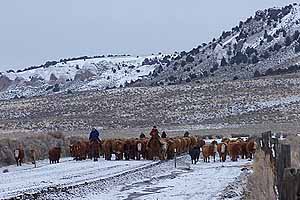
I happened across a website that lists and describes highway speed traps in all the states. Here are the Nevada Speedtrap listings, take them for what you think they’re worth — one clue might be the listing for “Morning”. I posted a comment: “Where the Hay is
Morning, Nevada?” No reply yet . . . On every October Saturday and Sunday beginning the 7th, from 11 am to 5 pm, the public is invited to visit The Corley Ranch on the south side of Gardnerville for the ‘2006 Harvest Festival Extraordinary!” This is indeed extraordinary, with live entertainment, miniature horses to ride or pulling a miniature carriage, a full-size horse drawn carriage, a Country Store, a Kiddie Land, vendors, crafters, a farm machinery display, food and drink, panning for gold, to say nothing of the Live Pig Races and 2-acre Corn Maze. On Saturday evenings from 7-9 p.m., visitors participate in the “Night Crawler Maze Event” a walk through the maze in the dark with their own flashlights . . . Lots of gooshy Lovelock love stories here . . .
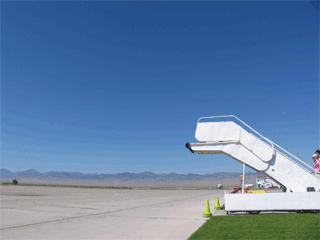
You can avoid long airport Security lines by flying out of Montello International Airport. Well, you can’t actually fly out, because even though the airport has a runway, a gift shop and lounges of sorts, no aircraft land or take off there — it’s an art project. But there are no security delays, and plenty of free parking . . .
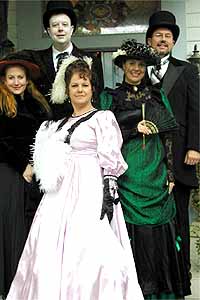
The Carson City Ghost Walk, is known as “Grave Concerns” this year. On Saturday, Oct. 21, you can tour a one-mile / 90-minute walk along the historic Kit Carson Trail in and about Carson City’s haunted buildings and Victorian homes. Ghosts and goblins from the Bruka Theatre Company of Reno materialize along the route, there are gunfighters in the alleys, and an occasional horse-drawn stagecoach careens wildly down the street re-enacting strange encounters of Carson City’s colorful past.
Overheard at the Liberty Bar in Ely: “To sell today’s lie, first you diminish yesterday’s truth.”
Happy Highways,



